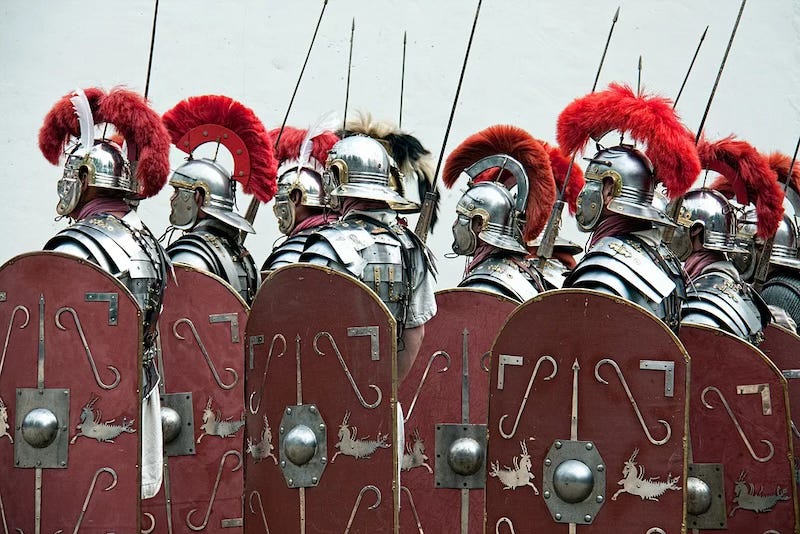Practice like a Stoic: 10, Act the opposite
Prepare yourself for some winter training and get off the hedonic treadmill
[This series of posts is based on A Handbook for New Stoics—How to Thrive in a World out of Your Control, co-authored by yours truly and Greg Lopez. It is a collection of 52 exercises, which we propose reader try out one per week during a whole year, to actually live like a Stoic. In Europe/UK the book is published by Rider under the title Live Like A Stoic. Below is this week’s prompt and a brief explanation of the pertinent philosophical background. Check the book for details on how to practice the exercise, download the exercise forms from The Experiment’s website, and comment below on how things are going. Greg and/or I will try our best to help out! This week’s exercise is found at pp. 73-76 of the paperback edition.]
“How much better to follow a straight course and attain a goal where the words ‘pleasant’ and ‘honorable’ have the same meaning! This end will be possible for us if we understand that there are two classes of objects that either attract us or repel us. We are attracted by such things as riches, pleasures, beauty, ambition, and other such coaxing and pleasing objects; we are repelled by toil, death, pain, disgrace, or lives of greater frugality. We ought therefore to train ourselves so that we may avoid a fear of the one or a desire for the other. Let us fight in the opposite fashion: Let us retreat from the objects that allure, and rouse ourselves to meet the objects that attack.” (Seneca, Letters to Lucilius, 123.12–13)
In an exquisite military metaphor, Seneca tells his friend Lucilius that he should adopt a strategy that is the opposite of what most people are inclined to do. We are attracted by material objects, or perhaps fame, or money; consequently, we decide that we need to do what we can to obtain them. Similarly, we do whatever we can to avoid things we truly dislike, such as hard work, pain, and of course death. Seneca’s advice is strange: We should train ourselves to not pursue the things we enjoy, and moreover, we should actively prepare to face the things we avoid. The latter is sometimes referred to as winter training—that is, what ancient soldiers used to do to keep themselves ready for battle. Even though they could not engage the enemy during the cold season, they would proactively exercise their skills during that time to prepare for the following fighting season. The same goes for us: Stoic training is not just a matter of withstanding adversity when it actually comes, but also of preparing ourselves ahead of it, during the good times.
Now why would anyone want to follow this recipe for what surely isn’t going to be a pleasant life? Keep in mind, as Seneca implies, that “pleasant” is a value judgment, not an objective fact of the world. And we are in charge of our judgments, which means that we can change them through consistent practice if reason tells us they are off track. Recall from last week our lexicographic ordering of things we value. Virtue is in the A set, not to be traded with anything else; other things—including riches, pleasures, beauty, and so on—are in the B set, to be preferred, but not at the cost of virtue, because they are not truly good and do not really make us happy. Turns out that this notion has some backing from modern psychology, in what is called the hedonic treadmill.
We have all experienced it: We salivate over a shiny new iPhone, we really want it, and we finally get it. For a few days we’re proud of our new possession; we admire it in our hands, we use it a lot. But a few weeks later it is just a phone, a utilitarian object (admittedly with some aesthetic appeal!), which can be replaced if lost or damaged, and which is certainly not going to change our life. And what do we do? Do we acknowledge that Seneca was right after all, that it is fruitless to spend so much time and energy desiring and pursuing external things? Of course not. We just shift our attention to the next shiny object. (Hey! That bag really looks nice. And I definitely need a new bag.) This will keep us “happy” for a few more days or weeks, and then the process will start over. Psychologists refer to this as the hedonic treadmill: Just like the treadmill at the gym, you keep running on it and don’t get anywhere. Unlike the one at the gym, this isn’t even good for your health!
Seneca, then, is telling us how to get off the hedonic treadmill. It’s a two-step process: First is the philosophical step of realizing that what is superficially pleasant may not make us happy—and conversely, that what appears to be unpleasant may not make us unhappy. Second, to act on our realization and little by little to internalize what we cognitively recognize to be the case: Every time you successfully retreat from the objects that allure you, and every time you successfully rouse yourself to meet the objects that attack you, you are taking a step toward wisdom and happiness.





I am a very routine-focused person, so this is a good one for me to practice — changing my schedule in a way I usually perceive as “negative” (not getting home from work at a particular time, having to do an extra chore, etc.), but instead thinking about it in neutral terms.
This brings to mind the subject of lesson 6 and adds another tool to practise being prepared for adversity.Shifting the focus from the new I phone to establishing a strategy for dealing with anxiety about future adversity appears to be a lot more conducive.